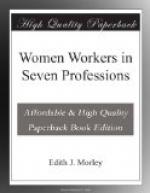III
SECONDARY SCHOOL TEACHING
The girls’ secondary day schools of this country, largely built up in the first place by the individual pioneer work of broad-minded women during the last thirty years of the nineteenth century, are now in most cases coming, if not under State control, at least into the sphere of State influence. These women educationists in some cases worked on old foundations, in others obtained from guilds or governors a share for girls’ education of funds previously allocated to various benefactions or to the education of boys only. Private enterprise, individual or, as in the case of the Girls’ Public Day School Company, collective, added schools in most important towns.
Thus by the beginning of the twentieth century there was provision for a large number of girls of the middle class up to eighteen years of age, in schools which as High Schools were analogous to the Grammar Schools for boys dating to a corresponding burst of educational activity rather more than three centuries earlier. Dependent on the fees of their pupils or on special funds or endowments, these schools could not, for the classes unable to pay a fee, adequately supplement the elementary schools of the country, which provide for such children education at most up to fourteen or fifteen years of age. The Education Act of 1902, therefore, placed education beyond this age in the hands of local authorities, the Board of Education supplementing the rates by grants for secondary education—so that publicly owned schools have been started by municipalities and County Councils, while other institutions receive grants on certain conditions.
Schools of all the types mentioned and a few others, providing education at least from ten to sixteen (or eighteen) years of age, are known as secondary schools, and it is to work in them that this article refers.[1] Various as may be their origins, and different their aims, the teachers in them form a fairly homogeneous group, with definite points in common, resulting from the requirements of the Board of Education for the earning of the grant now paid to most of these schools, or for the register in force for a short time—as well as from the co-ordinating influence of membership of the Headmistresses’ or the Assistant Mistresses’ Associations and other professional and educational bodies, and of educational literature from the publications of the Board of Education downwards.
It would be well if for this, as for other parts of educational work, people of middle age, or in fact all whose school days lie in the past, would dismiss their ideas gained from schools of even the end of the nineteenth century, and realise that the daily life of a school to-day is, in most cases, very different from that which they have in their minds. The time-table and the class-room work may not appear dissimilar to the casual observer, but a difference




